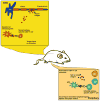Therapeutic blockade of T-cell antigen receptor signal transduction and costimulation in autoimmune disease
- PMID: 19065796
- PMCID: PMC2853772
- DOI: 10.1007/978-0-387-09789-3_18
Therapeutic blockade of T-cell antigen receptor signal transduction and costimulation in autoimmune disease
Abstract
CD4+ T-cell-mediated autoimmune diseases are initiated and maintained by the presentation of self-antigen by antigen-presenting cells (APCs) to self-reactive CD4+ T-cells. According to the two-signal hypothesis, activation of a naive antigen-specific CD4+ T-cell requires stimulation of both the T-cell antigen receptor (signal 1) and costimulatory molecules such as CD28 (signal 2). To date, the majority of therapies for autoimmune diseases approved by the Food and Drug Administration primarily focus on the global inhibition of immune inflammatory activity. The goal of ongoing research in this field is to develop antigen-specific treatments which block the deleterious effects of self-reactive immune cell function while maintaining the ability of the immune system to clear nonself antigens. To this end, the signaling pathways involved in the induction of CD4+ T-cell anergy, as apposed to activation, are a topic of intense interest. This chapter discusses components of the CD4+ T-cell activation pathway that may serve as therapeutic targets for the treatment of autoimmune disease.
Figures



References
-
- Steinman L, Martin R, Bernard C, et al. Multiple sclerosis: deeper understanding of its pathogenesis reveals new targets for therapy. Annu Rev Neurosci. 2002;25:491–505. - PubMed
-
- Von Boehmer H. T cell development and selection in the thymus. Bone Marrow Transplant. 1992;9(Suppl 1):46–48. - PubMed
-
- Rocha B, Vassalli P, Guy-Grand D. The extrathymic T-cell development pathway. Immunol Today. 1992;13:449–54. - PubMed
-
- Sospedra M, Martin R. Immunology of multiple sclerosis. Annu Rev Immunol. 2005;23:683–747. - PubMed
Publication types
MeSH terms
Substances
Grants and funding
LinkOut - more resources
Full Text Sources
Other Literature Sources
Medical
Research Materials
Miscellaneous

